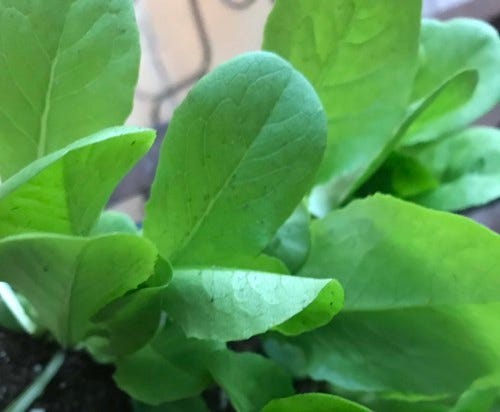In the North Carolina Piedmont, it’s time to plant lettuce. Even with the prediction of light snow in the second week of March, I got a six-pack starter of lettuce transplants and a couple of varieties of seeds to try out. The seed came in handsome packages from Southern Exposure Seed Exchange, a worker-owned co-op in Mineral, Virginia. The company explains that lettuce plants can survive temperatures of 20 degrees Farenheit. Lettuce will come up even when it’s 40 degrees outside though temperatures in the 70s are optimal for seed germination. My hankering for homegrown lettuce was inspired by a bit of history I learned only this week.
Bibb lettuce from Southern States in Carrboro, NC. Photo by Donna Campbell
While planning an early April trip to Cincinnati for a conference, I was also plotting a food foray across the Ohio state line into Kentucky. My friend Roberta Schultz of Wilder, KY—a brilliant singer/songwriter and occasional basement beer brewer with her husband, Gary–offered to show me around. Roberta, also a faithful reader of this blog, promises we’ll sample beer cheese—a Kentucky dip made with the eponymous ingredients plus garlic and cayenne. She also insists that I sample Goetta–a breakfast protein made of chopped pork, steel cut oats, onions, and broth. Shaped into a brick, Goetta is then sliced into thin slabs and fried, much like the liver mush that’s served in North Carolina–definitely an acquired taste, I’m guessing.
When I googled these items I also discovered that 2018 has been declared “The Year of Kentucky Food,” a campaign to boost tourism, delivered on a website that divides the state into nine regions and regales would-be travelers with descriptions and photos of the state’s most essential dishes. I have already sampled a good many of the esteemed bourbons, and I’ve tried Louisville’s celebrated Hot Brown–an open faced sandwich of turkey topped with mornay sauce. Long ago on a cross country trip, I stopped in the lakes region to sample the local yeast bread baked in flower pots. On another trip we dined at the Colonel’s original KFC–a sit-down restaurant. Then there’s Derby pie and corn pudding–check, check.
I have never tried Kentucky Burgoo (what we might call Brunswick stew here)–a concoction of multiple meats and whatever vegetables might be available to throw in a big iron pot to cook down. Nor have I sampled the mutton barbecue cooked up daily in Owensboro, nor the famous spoon bread served at Berea College. But one native dish from the middle of the state stopped me in my tracks.
Who knew that Bibb lettuce got its name from a Kentucky lawyer and legislator turned horticulturist? John Bibb (1789-1884) served in the War of 1812 and ultimately settled in the state capital of Frankfort, where he bred a sweet lettuce that he called Limestone. Sometime after the Civil War, Bibb began sharing his special lettuce seeds with friends and neighbors, and its popularity grew. A greenhouse in Louisville was selling the seeds far and wide by the 1920s. The inimitable taste of what came to be known as Bibb lettuce, however, turned out to be contingent on its native terroir–namely, central Kentucky’s limestone infused soil which John Bibb obviously understood, having originally named his leaf after the mineral. Though Bibb lettuce had become a national favorite by the middle of the twentieth century, the heirloom leaf was notably fragile and did not travel well.
As the Year of Kentucky Food website explains, Bibb’s tender leaves fell from national prominence in the 1970s when the reign of chains began, and pre-cut salad ingredients were trucked and then laid out under bright lights and sneeze guards in the all-you-can-eat salad bars of budget steak houses. Furthermore, as the website puts it: “With chain groceries opting for prewashed lettuce sold in plastic bags or protective plastic boxes, Bibb’s delicacy again became a liability,”
Bibb lettuce nevertheless remains a local favorite in the Bluegrass State, trotted out especially at Derby time and often served with a signature local dressing known as Benedictine–a fluffy cream cheese concoction that includes cucumber and onion juice. Also served as a spread, Benedictine was invented around 1900 by a Louisville caterer and cookbook author named by Jennie Carter Benedict. (Recipes are easy to find on line.)
The ephemeral quality of Bibb lettuce and its preferred provenance of soil laced with limestone is precisely the kind of food that I write about in my new book, The Month of Their Ripening. It is so rare nowadays that a particular fruit or vegetable can’t be bred to survive shipping across state and national borders to meet our first-world appetites and expectations. Think cantaloupe–so rarely delicious because of premature picking. Yet the geographic limit on true Bibb lettuce is what draws me to it. Though Bibb, like many heirloom vegetables, can be commercially grown organically and hydroponically, experts say that this kind of cultivation just doesn’t carry the same flavor.
Of course, there are other similar varieties—Buttercrisp and Boston, for example—that may be decent approximations. But we are missing John Bibb’s discovery–the candy-sweetness created by a special mineral in the soil, (also an essential part of the story of Doug and Wheeler Munroe’s delicious maple syrup discussed in the previous blog entry.)
Though it may be a fool’s errand, I am planting Bibb lettuce in my garden, and I will apply a bit of lime to try and sweeten the soil. I’ve had the soil tested, and it’s pretty neutral, so we’ll see what happens, if the deer and rabbits don’t beat me to it.
I’ll report back on the Goetta and Beer Cheese in April.





